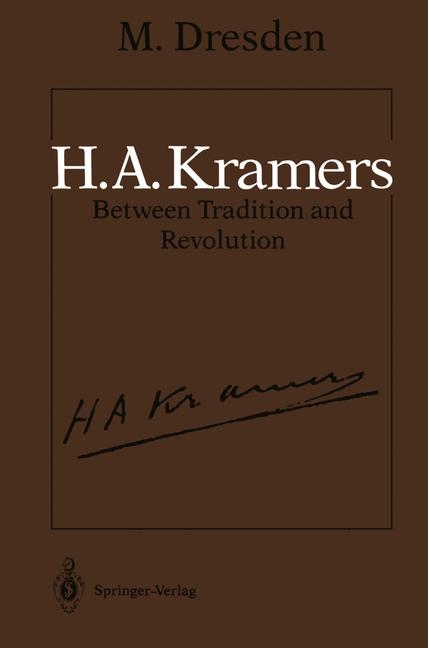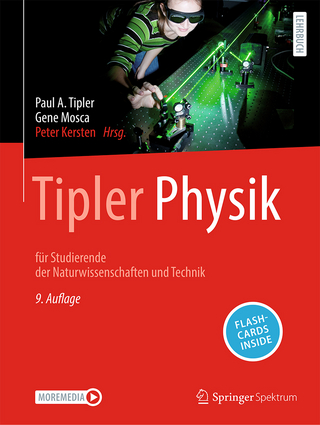
H.A. Kramers Between Tradition and Revolution
Springer-Verlag New York Inc.
978-0-387-96282-5 (ISBN)
- Titel ist leider vergriffen;
keine Neuauflage - Artikel merken
It is now a little more than 11 years since the idea of writing a personal and scientific biography of H. A. Kramers took hold of me. A few days earlier I had been lecturing, in a course on field theory, on the renormalization proce- dures of relativistic quantum field theory. Since the students had considerable trouble understanding the physical basis of the procedure, at the end of the lecture T explained that renormalization is not an exclusive quantum or relativistic procedure. A careful treatment of classical electron theory as started by Lorentz and developed in detail by Kramers also requires re- normalization. The students appeared quite interested and I promised them that I would explain all this in more detail in the next lecture. I could have looked up this material in Kramers' book, but I remembered that Kramers had stressed this idea in a course I had attended in Leiden in 1938-1939. I did dig up some of these old notes and, although they were considerably less transparent than my recollection seemed to indicate, they reminded me force- fully of the thrilling days I had spent in Leiden with Kramers. Kramers' deep insight and originality were apparent even when distorted by my opaque notes. The students had never heard of these ideas of Kramers' and were totally unaware of his work in field theory.
1 A Remarkable Person in a Very Special Epoch.- 1 H. A. Kramers: Why a Biography?.- 2 The Classical Synthesis: Lorentz.- 3 The Unraveling of Classical Physics: Planck and Einstein.- 4 Conflicts and the Basic Incompatibility.- 5 Bohr: Success and Ambiguity in a Period of Transition.- 6 Bohr, the Photon, and Kramers.- 7 The Bohr Institute: Pauli and Heisenberg.- 8 From Virtual Oscillators to Quantum Mechanics.- 9 The Revolution in Progress.- Notes for Part 1.- 2 Living Through a Revolution.- 10 A Hesitant Start with an Unusual Twist.- I. Youth and General Background.- II. The Leiden Years (1912–1916).- III. The Arnhem Interlude.- 11 The Early Copenhagen Years: From Student to Apostle.- I. Summary: Between Leiden and Copenhagen.- II. The Initial Contacts Between Kramers and Bohr.- III. Elaboration and Extensions of the Bohr Theory.- IV. Kramers’ Contribution to the Bohr Theory: The Thesis.- V. The Changing Status of Kramers.- VI. How Parsimonious the Emotions?.- 12 From Apostle to Prophet: Hints of Trouble to Come.- I. Helium: The First Failure.- II. More Problems: What Is the Right Direction?.- III. The “Virtual” Encounter of Kramers and Heisenberg.- IV. The Gospel According to Kramers and Holst.- V. The Great X-Ray Paper: The Last Success.- 13 The Multifarious Consequences of a Desperation Revolution.- I. The Struggle About the Photon.- II. The Kramers Dispersion Theory: Not a Consequence but a Success.- A. The Unreliability of Chronology.- B. Dispersion Theory: Background and Basic Ideas.- C. The Kramers Derivation.- III. The Bohr—Kramers—Slater Theory.- A. Background:Slater’s Ideas.- B. Bohr—Kramers—Slater: The Interplay of Personalities.- C. The Bohr—Kramers—Slater Theory: Basic Ideas.- D. The BKS Theory: Reflections and Second Thoughts.- E. The Compton Effect in the BKS Theory.- F. The Intellectual Framework of Kramers’ Physics.- G. Kramers’ Personal Elaborations.- H. The Reception of the Theory.- I. The Crash.- IV. The Road to Quantum Mechanics: The Changing of the Guard.- A. The Kramers—Heisenberg Dispersion Theory Paper: Background and Chronology.- B. General Approach Between Virtual Oscillators and Matrices.- C. Technical Matters: The Old Method and New Puzzles.- D. From Virtual Oscillators to Matrices: Heisenberg Goes It Alone.- E. The Personalities of Pauli, Heisenberg, and Kramers: The Strange Path from Deference to Ridicule to Doubt.- F. The Changing Patterns.- G. Why Didn’t Kramers Discover Quantum Mechanics?.- 14 The Curious Copenhagen Interlude.- I. The Events.- II. Recollections and Some Documentation.- III. Conclusions.- Notes for Part 2.- 3 Waiting for a Revolution That Did Not Happen.- 15 The Search for Identity in Changing Times.- I. The Move to Utrecht.- II. The Change in Style and Mood.- III. The Scope of Kramers’ Activities.- IV. Kramers’ Contributions to Statistical Mechanics.- 16 The Recurrent Theme: Electrons and Radiation.- I. Kramers’ Approach: The Legacy of Lorentz and Bohr.- A. Lorentz’s Influence.- B. Kramers’ Uneasiness with the Dirac Radiation Theory.- C. The Chronology of an Obsession.- II. The Struggle Toward a Consistent Theory.- A. The Construction of the “First” Kramers’ Hamiltonian.- B. Further Elaborations of Kramers’ Ideas.- III. The Story of Two Conferences: Shelter Island and Solvay.- A. The Pre-Shelter Island Status: The April 1944 Lecture.- B. The Shelter Island Conference: Kramers’ Presentation.- C. The Solvay Report: Culmination and Termination of Kramers’ Program.- D. Culmination or Oblivion: Van Kampen’s Thesis.- IV. Retrospect: The Postponed Recognition.- A. The Lamb Shift: How High the Stakes.- B. The Convoluted Recognition.- C. What Went Wrong? Can One Be Too Principled?.- Notes for Part 3.- 4 Kramers as a Person and a Scientist: Conflict or Harmony?.- 17 Personality and Style.- I. The Assessments: Public and Personal.- II. The Conundrum of the Near Misses.- A. The Role of Near Misses.- B. The Litany of Near Misses.- C. Interlude: Near Miss Number 9—The S Matrix Incident.- D. Near Misses Concluded: Omissions and Style.- III. Elements of Kramers’ Scientific Style.- A. The Role of Fear and Courage.- B. Characteristics of Kramers’ Scientific Style.- C. The Role of Mathematics, Structures, Abstractions.- IV. Personal Matters.- A. Some Personal Traits.- B. The Surroundings.- C. The Interpersonal Relations.- D. Fear and Decency.- 18 Obligation and Duty.- I. The Equivocal Role of Religion.- II. Obligation and Duty.- III. The Special Role of Teaching.- IV. Duty: The War and Its Aftermath.- A. The Wartime.- B. Kramers’ Work in the United Nations.- 19 Kramers’ Self-Image.- I. Kramers and the Psychology of Physicists.- II. Kramers’ Lecture on Debye: What Is an Ideal Scientific Biography?.- III. Fragments from Notebooks and Diaries.- A. From the Notebooks: Science and Scientists.- B. From the Diaries: The Person and His Demons.- C. From the Diaries: Personal Entanglements.- D. The Story of Camilla.- E. The Poems.- 20 Epilogue: Does One Know Better—Understand More?.- I. The Objective Recognition: Prizes and Awards.- II. Finale.- Appendix: Poems.- Notes for Part 4.
| Zusatzinfo | XXIV, 563 p. |
|---|---|
| Verlagsort | New York, NY |
| Sprache | englisch |
| Gewicht | 960 g |
| Themenwelt | Naturwissenschaften ► Physik / Astronomie ► Allgemeines / Lexika |
| ISBN-10 | 0-387-96282-4 / 0387962824 |
| ISBN-13 | 978-0-387-96282-5 / 9780387962825 |
| Zustand | Neuware |
| Haben Sie eine Frage zum Produkt? |
aus dem Bereich


